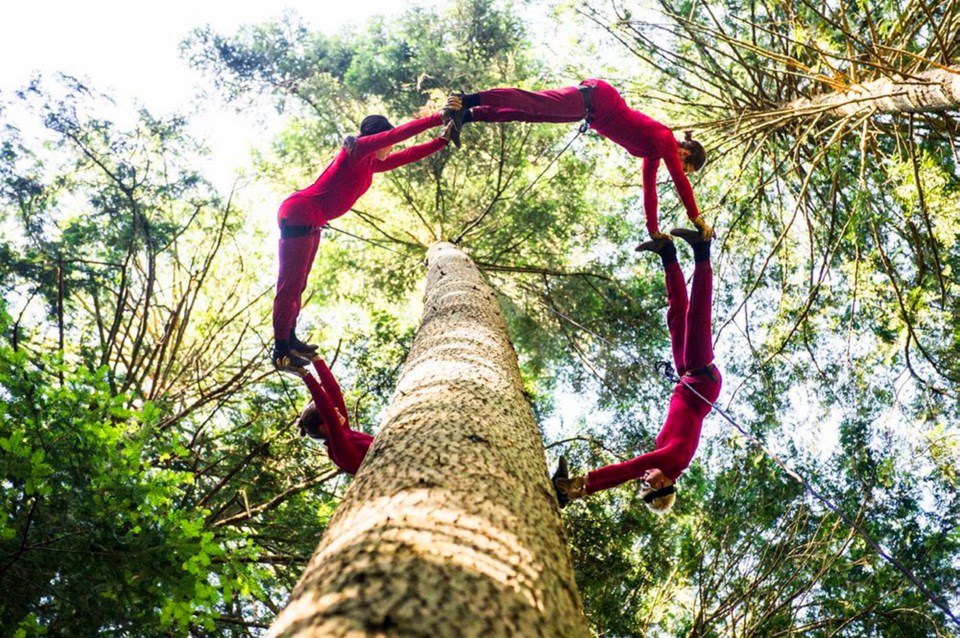PREVIEW
What: Aeriosa
Where: Saxe Point Park, Esquimalt
When: Friday and Saturday (three 20-minute performances daily, starting at 6:30 p.m.)
Admission: Free
Dancing with Vancouver’s Aeriosa troupe sounds… well, a bit scary.
Aeriosa is the only company in Canada specializing in vertical dance, in which performers spin and dance on cables from trees, buildings and mountains.
Victorians will get the chance to see for themselves when Aeriosa twirls from the treetops of Saxe Point Park on Friday and Saturday. The 20-minute performances — free to the public — are presented by Esquimalt’s Township Community Arts Council.
One of the four dancers is Alia Saurini, a Victoria native who has taken time off from Cirque du Soleil to perform with Aeriosa. She’s untroubled by the prospect of spinning from the tops of Douglas fir trees.
“I’m used to it. I’m constantly dangling in the air,” Saurini said with a laugh. “I trust the people that are doing it. I have to. Every day I work, I put my life into somebody else’s hands.”
Aeriosa has performed at such locations as Toronto’s 58-storey L Tower and the Stawamus Chief, a 700-metre-high mountain peak in Squamish. The company has performed in Victoria several times, including a 2012 show from the CRD building at Centennial Square.
Julia Taffe is Aeriosa’s founder, artistic director and choreographer. Since 1998, she has choreographed more than 25 works for her company. She says dancing among the clouds is no big deal, adding that “fear is healthy.”
The key, Taffe adds, is to put safety first. Aeriosa works with a team of professional riggers. Before the Saxe Point show, the site will also be inspected by a “mountain safety specialist,” who will closely monitor the weather, rain or shine.
Aeriosa travels to Victoria on the heels of a treetop show in Stanley Park. Taffe, a Vancouverite who briefly lived in Victoria, became increasing interested in tree-dancing since moving to Tofino five years ago.
“That’s where we really started exploring this idea,” she said.
Taffe says she has already inspected the Saxe Point Park site — and is impressed.
“It’s incredible. It’s such a gem, that park. These trees are right beside the ocean. It’s a unique perspective to be overlooking the water that way.”
Such is her enthusiasm for dancing in trees, she refers to it as an “interspecies” collaboration. Because trees are a living thing, Aeriosa takes care not to damage them — making sure not to snap branches or leave metal spikes.
“If we can’t do our work without damaging the environment, then we shouldn’t do it,” Taffe said. “Each tree is unique and you have to be able to respond to that with your choreography and your artistic vision.
“And every day in the tree is different. Some days, there’s more pollen, some days the bark is a little drier and it rubs on you in a different way. Other days, it might be a pine cone coming down.”
Although dancing suspended from cables limits movement, it also opens up new possibilities. Using this method, dancers can give the impression of weightlessness and execute moves unavailable to earth-bound performers, such as spinning in the air for extended periods.
(Somewhat similar work has been done by Victoria dance inventor Sven Johansson, whose teeter-totter-like E.S. Dance Instrument also makes it appear that performers can fly.)
Taffe was attracted to vertical dance because it pulls dance out of traditional theatre spaces. With public shows in outdoor locations, the art form is thrust “into the world,” she says.
“Contemporary dance has this impression of being this esoteric art form and a difficult thing to understand. But at its heart, we’re just dancers, we’re movers.”
If anyone seems destined for a career in vertical dance, it’s Taffe. She trained with the Royal Winnipeg Ballet, Toronto Dance Theatre and the Winnipeg School of Contemporary Dancers. Then, Taffe turned her attention to rock- climbing, becoming a guide certified by the Association of Canadian Mountain Guides.
She decided to combine her love of rock-climbing and dance. She toured with Project Bandaloop, a vertical-dance company in San Francisco. At first, unable to find colleagues in such a rarefied field within her home province, Taffe worked solo. Then she formed Aeriosa.
When she started out in the late 1990s, vertical dance wasn’t accepted by the traditional dance community.
“I definitely felt like an outsider in the beginning. I did receive feedback on peer juries on grants, that they didn’t think [vertical dance] was dance,” Taffe said.
Times have changed. Today, she feels the art form is much more accepted by the artistic community and audiences.
“This trans-disciplinary blending of sport, art and environment— to me, it makes a lot of sense in our world right now,” Taffe said.



